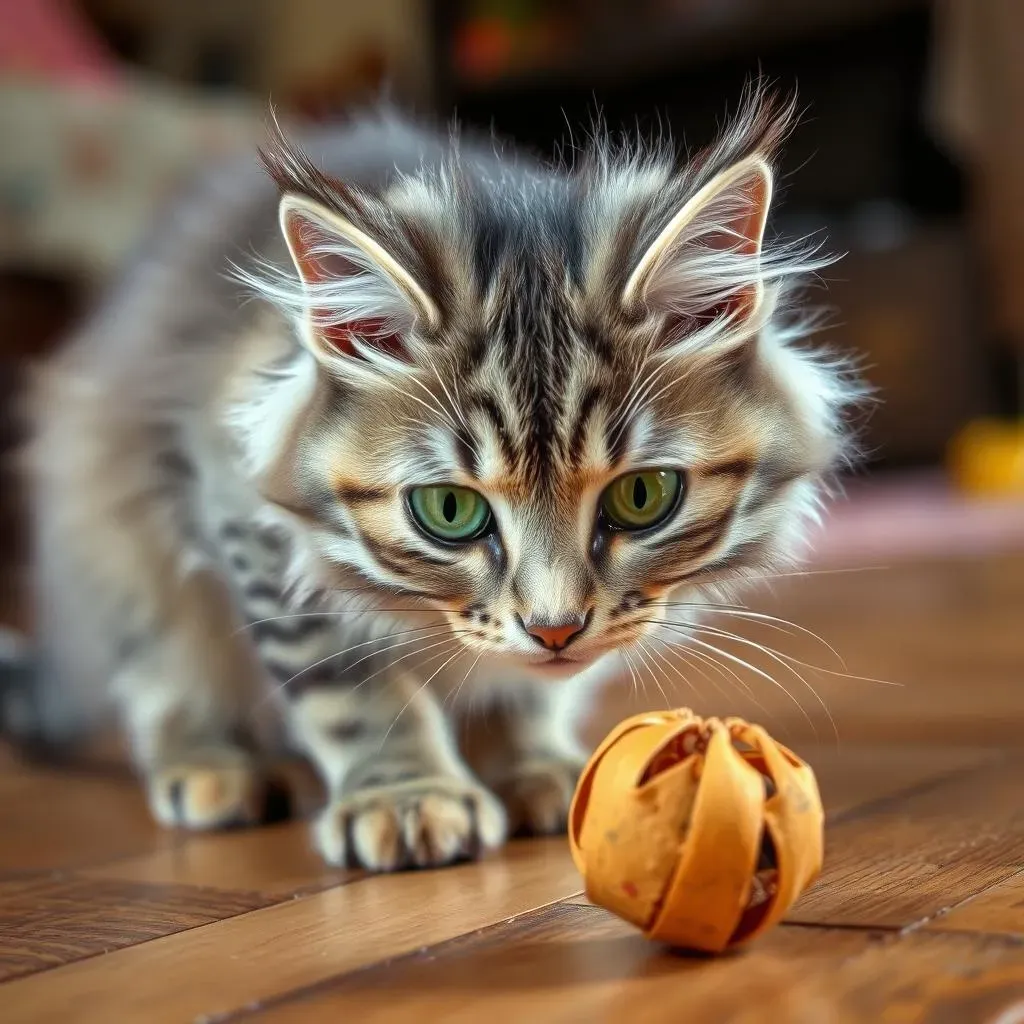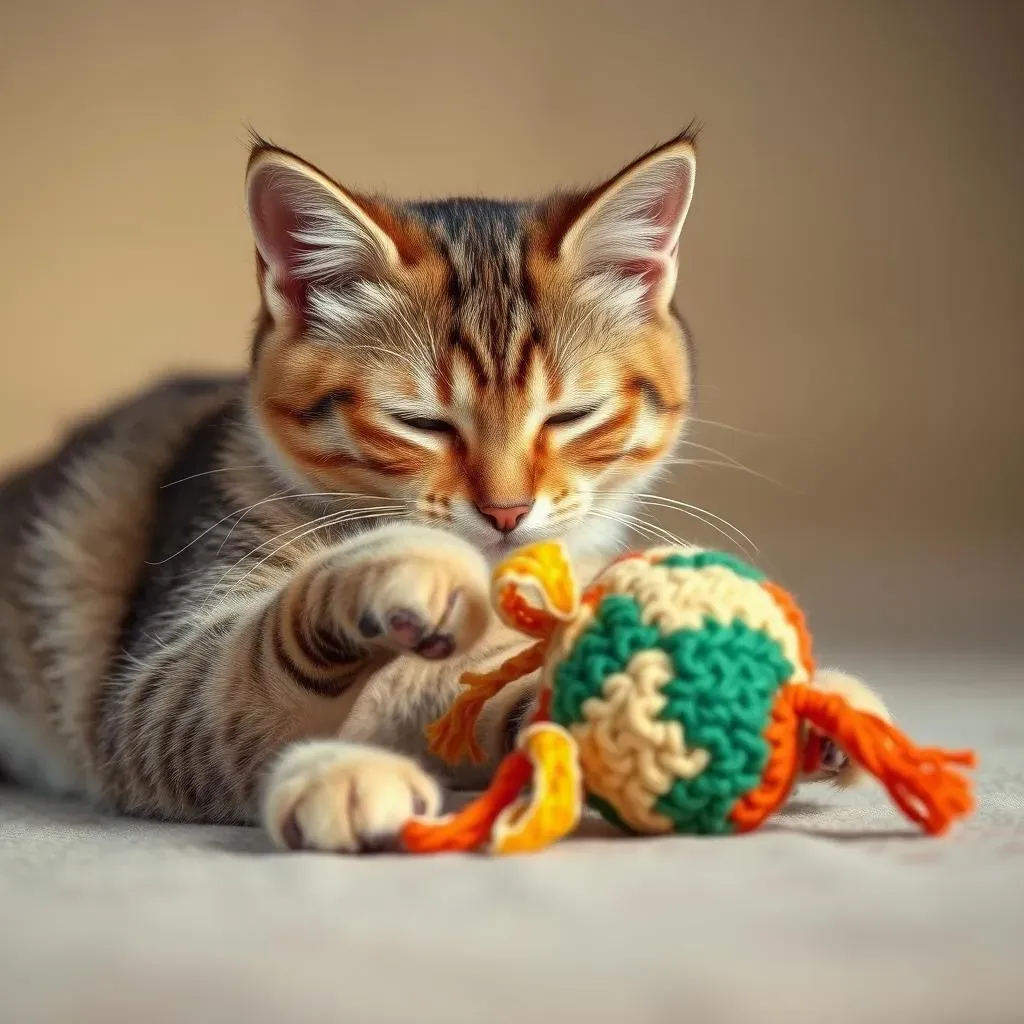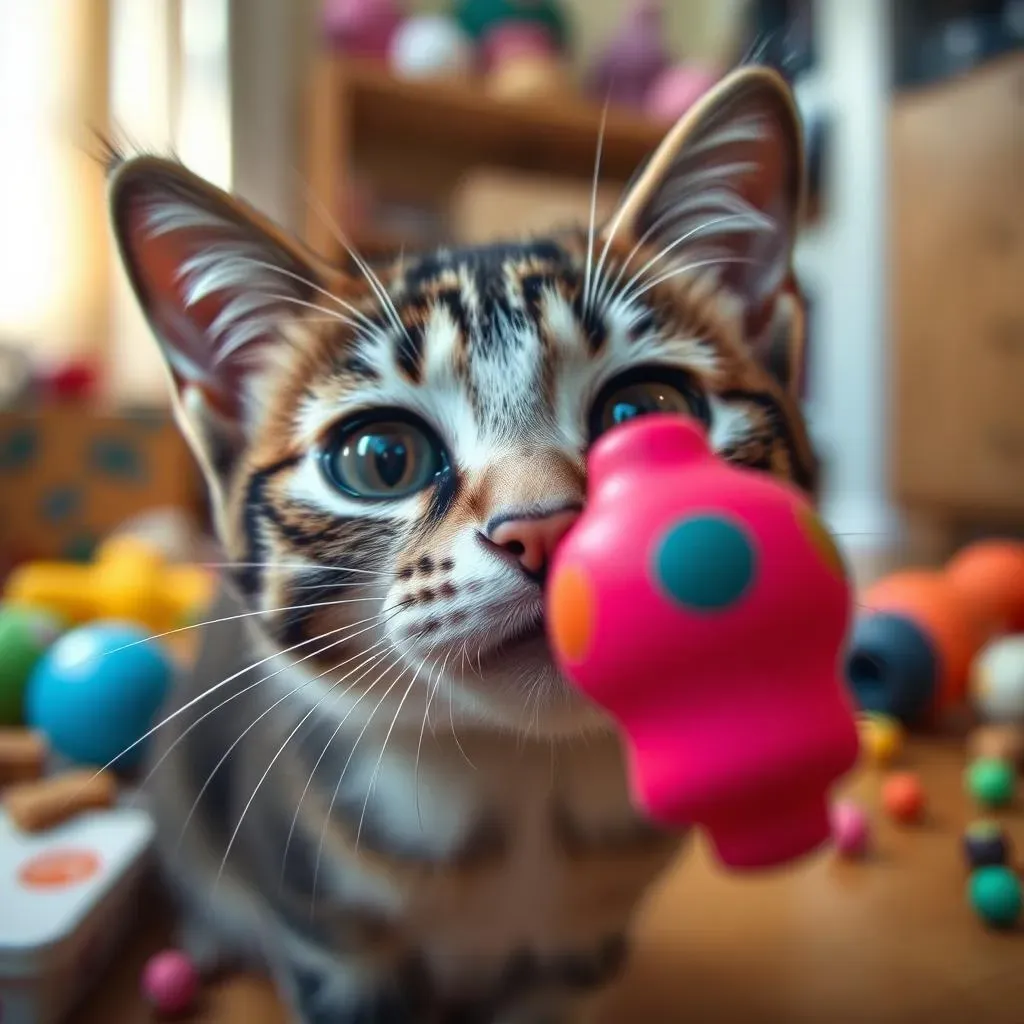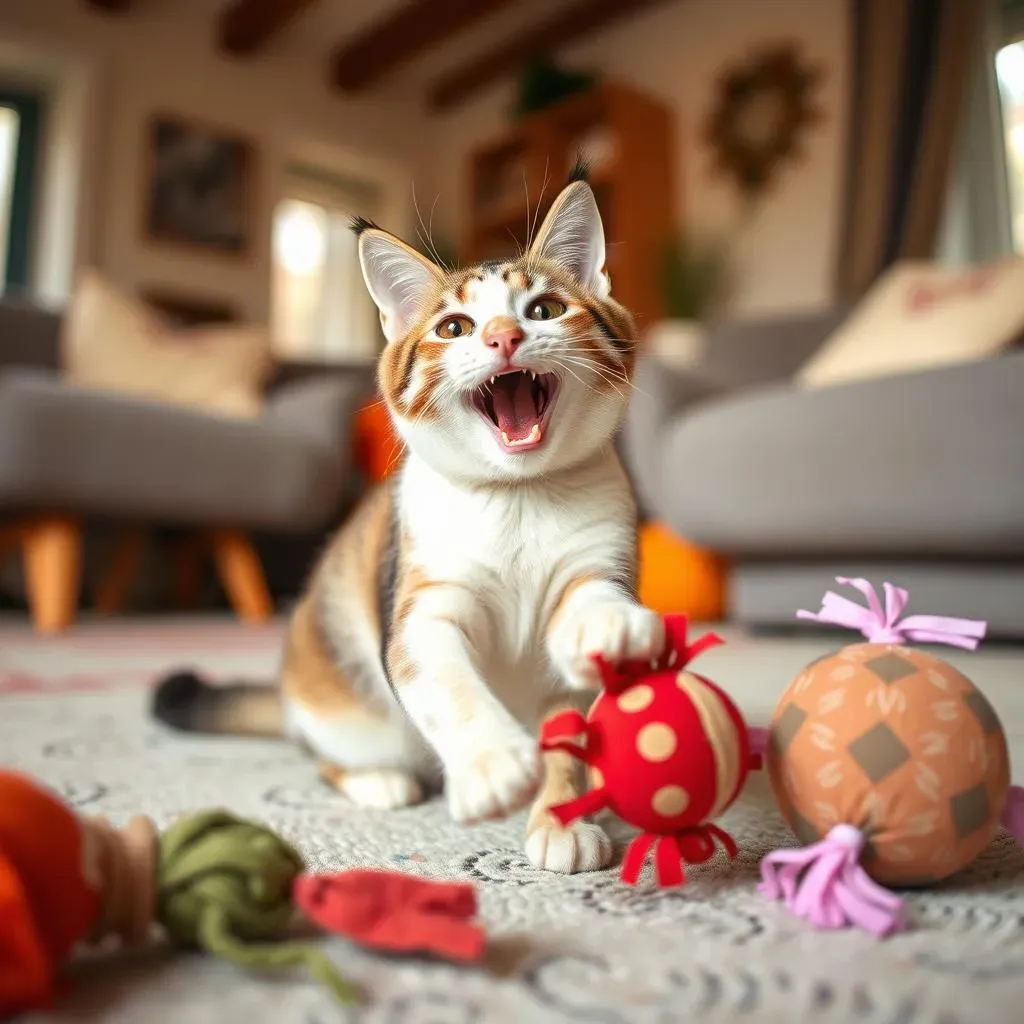Table of Contents
Ever watched your cat stalk a dust bunny with the intensity of a lion hunting a gazelle? Then you know, cats have a playful side, and some are surprisingly into fetch. Forget the dog stereotypes, many felines love a good chase and return—sometimes. Finding the right toy is key to unlocking this behavior. This article will guide you through the wonderful world of best cat fetch toys. We'll explore why some cats are fetch fanatics, and what makes a toy irresistible to them. We'll look at the materials, shapes, and sizes that will have your kitty leaping, batting, and bringing things back. We'll also cover how to engage your cat in fetch, and give you some ideas for making your own toys. Get ready to discover the perfect fetch toy and watch your cat's inner athlete emerge!
Why Cats Love to Fetch (and Which Toys They'll Actually Chase)

Why Cats Love to Fetch (and Which Toys They'll Actually Chase)
The Hunter's Instinct
so not every cat is going to be a golden retriever in disguise, but many cats have a natural drive to hunt. It's in their DNA, a holdover from their wild ancestors. That little twitch of the tail, the focused stare, the pounce - it's all part of that ingrained hunting sequence. Fetch, for some cats, is a way to play out this instinct without having to actually catch a mouse. They get the thrill of the chase, the satisfaction of the "kill," and the reward of bringing their prize back to you. It's like a mini-safari in your living room, and they're the fearless explorers.
It's not just about the hunt itself, though. For some cats, the social aspect of fetch is really important. It's a way for them to bond with you, interact, and get that one-on-one attention. When your cat brings the toy back, they're kind of saying, "Look what I got! Now throw it again!" It's a game, a conversation, and a way to connect.
What Makes a Toy Irresistible?
So, what kind of toys are going to spark that inner hunter? Well, it's not always about the fanciest, most expensive cat toy on the market. Cats are often drawn to things that mimic prey. Think small, lightweight, and easy to bat around. Crinkly textures, feathers, and anything that moves erratically are usually a hit. It's all about that element of surprise and challenge. A boring, predictable toy isn't going to hold their attention for long. They want something that engages their senses and makes them feel like they're on the prowl.
Also, consider your cat’s personality. Some cats love to chase things across the floor, while others prefer to bat things in the air. Watch what your cat naturally gravitates towards, and use that to guide your toy choices. For example, my cat, Whiskers, has a weird obsession with those little plastic rings that come off milk jugs, she'll chase them for hours. It's not fancy, but it works.
Toy Type | Why Cats Love It |
|---|---|
Crinkly Balls | Mimics the sound of prey, lightweight |
Feather Wands | Simulates the movement of birds |
Small Mice | Resembles small prey, easy to bat |
Laser Pointers | Irregular movement, triggers the chase instinct (use sparingly) |
The Return: Why (Sometimes) They Bring it Back
Now, here's the tricky part: the "return" part of fetch. Not all cats are going to bring the toy all the way back to you. Some might drop it halfway, some might just stare at you expecting you to come get it, and some might just run off with it. It’s important to remember that cats are not dogs, and their motivations are different. They might bring it back because they enjoy the interaction, because they want you to throw it again, or maybe they just want to show off their prize. Or maybe they just forgot what they were doing. Who knows what goes on in those little cat brains?
The key is to be patient and to celebrate any attempt at a return. Even if they only bring it halfway, praise them and throw it again. Don't force it, and don't get discouraged if they don't always bring it back. It's all about having fun and engaging with your cat, and if they get exercise and enjoyment out of the process, then that's what really matters. After all, it's their game, and we're just here to play along.
Top Materials and Designs for the Best Cat Fetch Toys

Top Materials and Designs for the Best Cat Fetch Toys
Safe and Durable Materials
so you've got a cat who's ready to chase, but what exactly should those toys be made of? Safety is key, of course. You don't want anything that could be easily chewed apart and swallowed. Think about natural fibers like cotton, wool, or even tightly woven canvas. These are usually safe for your cat to mouth and bat around. Avoid anything with small, detachable parts that could pose a choking hazard. Plastic toys should be made of sturdy, non-toxic materials, and always check them for cracks or damage. It's better to replace a toy than risk a trip to the vet.
Durability is also important, especially if your cat is a rough player. I've had toys that barely lasted five minutes before being reduced to a pile of fluff. Look for toys that are well-stitched, with reinforced seams. Some materials, like felt, can be pretty durable but may not stand up to extreme chewing. It really depends on your cat's play style. If you have a super chewer, you might want to stick to tougher materials like rubber or hard plastic, but always supervise them with these types of toys.
Designs That Spark the Chase
Now let's talk about design. The best cat fetch toys have features that make them fun to chase. Lightweight is essential, because your cat needs to be able to pick it up in their mouth, bat it around, and carry it back (hopefully!). Small size is also good, because they need to be able to get their paws on it. Think about the shape, too. A round ball is a classic option, but don't be afraid to experiment with other shapes, like small mice, crinkly balls, or even those little springs that bounce around unpredictably.
Texture is another important aspect. Cats love toys with interesting textures, like crinkly fabrics, soft fur, or even bumpy surfaces. These textures can make the toy more appealing and engaging. Also, consider the movement of the toy. Toys that roll or bounce erratically tend to be more exciting than toys that just sit there. And don't underestimate the power of a little bit of catnip to really get your cat interested in a new toy. It's like cat crack, but in a good way.
Material | Pros | Cons |
|---|---|---|
Cotton/Wool | Natural, soft, relatively safe | Can be chewed apart |
Canvas | Durable, can withstand some chewing | May not be as enticing as other materials |
Hard Plastic | Very durable, easy to clean | Can be noisy, may not be as soft |
Rubber | Durable, good for chewers | Can be heavy, some cats may not like the texture |
Feathers | Enticing, mimics prey | Can be easily destroyed, not durable |
Interactive Play: How to Get Your Cat Engaged with Fetch Toys

Interactive Play: How to Get Your Cat Engaged with Fetch Toys
Setting the Stage for Success
Alright, so you've got the perfect toy, now how do you actually get your cat interested in playing fetch? It's not always as simple as just tossing it and hoping for the best. Start by creating a positive and engaging play environment. Make sure you're in a space where your cat feels comfortable and safe. Avoid forcing them to play, and instead let them come to you. Sometimes, a little bit of pre-play can help get them in the mood. Try using a wand toy or laser pointer to get them moving, and then introduce the fetch toy. The idea is to get their hunting instincts activated, so they're more likely to chase.
Timing is also crucial, try playing with your cat when they are most active and playful. This is often in the early morning or evening. Avoid playing with them right after they've eaten, because they may be feeling sleepy or full. Keep the play sessions short and sweet, 5-10 minutes is usually enough for most cats. It's better to have a few short, enthusiastic sessions than one long, boring one. And remember, the goal is to have fun, so don't get frustrated if your cat doesn't immediately take to fetch. It might take some time and patience, but it's worth it when you see them enjoying themselves.
The Art of the Throw
The way you throw the toy can also make a big difference. Don't just hurl it across the room like you're throwing a baseball. Try to mimic the movement of prey. Toss it gently so it bounces or rolls in an unpredictable way. This will make it more enticing for your cat to chase. You can also experiment with different throwing techniques. Some cats love to chase toys that are tossed up in the air, while others prefer toys that roll along the ground. Observe what your cat responds to best and adapt accordingly. The key is to keep it interesting and engaging. And remember, don't be afraid to get down on the floor with your cat and get involved in the game. It's a great way to bond and have some fun together.
Another good tip is to vary the distance of your throws. Start with short distances and gradually increase them as your cat gets more comfortable with the game. This way, they won't get overwhelmed and they can build up their confidence. You can also use a verbal cue, like "fetch" or "get it" to help them associate the action with the game. Eventually, they might even start to anticipate the throw and get excited when they hear the cue. It's like training a dog, but with a cat's unique personality and quirks.
"The smallest feline is a masterpiece." - Leonardo da Vinci
Keeping It Fun and Rewarding
The most important thing is to make fetch a positive experience for your cat. Use positive reinforcement, like praise, petting, or even a small treat to reward them when they engage in the game. This way, they'll associate fetch with positive things, and they'll be more likely to play again. Don't scold them or punish them if they don't bring the toy back. Remember, it's their game, and they set the rules. Also, keep an eye on your cat's body language. If they seem tired, uninterested, or overwhelmed, it's time to stop playing. You don't want to push them too hard, or they might start to avoid playtime altogether.
Finally, remember that not every cat is going to be a fetch fanatic, and that's okay. The goal is to find activities that your cat enjoys and that keep them active and healthy. Even if your cat prefers a different type of play, like chasing a laser pointer or batting a toy on a string, the important thing is that you're spending time together and providing enrichment for your furry friend. And who knows, even if your cat doesn't love fetch now, they might change their mind in the future. Just be patient, persistent, and keep trying new things. It's all part of the fun of being a cat owner.
Tips for Engaging Play | Why It Works |
|---|---|
Short, frequent sessions | Keeps cats interested and prevents overstimulation |
Varied throwing techniques | Mimics prey movement, more engaging |
Positive reinforcement | Encourages cats to play |
Respect their limits | Prevents stress and disinterest |
DIY and BudgetFriendly Options for the Best Cat Fetch Toys

DIY and BudgetFriendly Options for the Best Cat Fetch Toys
Household Treasures: Repurposing for Play
so you don't need to break the bank to find awesome fetch toys for your cat. Seriously, some of the best toys are probably already lying around your house. Think about those empty cardboard toilet paper rolls, they can become a cat's best friend. You can cut them into rings, fold them into little boxes, or just let your cat bat them around. They're lightweight, they make a satisfying noise, and they're totally free. Also, those plastic rings that come off milk jugs? My cat goes nuts for those. They’re perfect for batting and chasing, just make sure they're clean and free of sharp edges. And don't forget about paper. Crumpled up balls of paper are a classic cat toy that never gets old. You can even add a little catnip inside for extra fun. It's all about thinking outside the box and seeing the potential for play in everyday items.
Another great option is to use old fabric scraps. Cut them into strips, tie them together, and you've got a fun, textured toy. You can also sew them into little pouches and stuff them with catnip for a super engaging toy. Old socks can also be repurposed into toys. Stuff them with cotton batting or fabric scraps, tie them off, and you’ve got a soft, cuddly toy that your cat will love to bat around. The beauty of DIY toys is that you can customize them to your cat's preferences. If your cat loves crinkly sounds, use cellophane or plastic bags inside the toy. If they love soft textures, use fleece or cotton. It's all about experimenting and seeing what your cat likes best.
Crafty Creations: Simple DIY Projects
If you're feeling a little crafty, you can create some simple DIY toys that your cat will love. A feather wand is a classic cat toy that's easy to make. Just attach some feathers to the end of a stick or a dowel using string or glue. You can also use ribbons, yarn, or even strips of fabric instead of feathers. The key is to make it lightweight and easy to move around. You can also create a simple "fishing pole" toy by attaching a toy to the end of a string and then attaching that string to a stick. This is great for interactive play and will encourage your cat to jump and chase. I made one with some old yarn and a cork, and my cat was entertained for hours.
Another fun DIY project is to create a puzzle toy. Take an empty cardboard box and cut holes in the sides. Then, put some small toys or treats inside. Your cat will have to figure out how to get the goodies out, which is great for mental stimulation. You can also create a "snuffle mat" by attaching strips of fabric to a rubber mat or a piece of cardboard. Then, hide some treats in the fabric and let your cat sniff them out. These DIY toys are not only fun for your cat, but they're also a great way to recycle and repurpose materials. Plus, you get the satisfaction of knowing that you made something your cat loves with your own two hands.
DIY Toy Idea | Materials Needed | Why Cats Love It |
|---|---|---|
Cardboard Roll Rings | Empty toilet paper or paper towel rolls | Lightweight, easy to bat, makes noise |
Fabric Scrap Toy | Fabric scraps, string or yarn | Textured, can be filled with catnip |
Feather Wand | Stick or dowel, feathers, string or glue | Mimics prey, encourages jumping |
Puzzle Box | Cardboard box, small toys or treats | Mental stimulation, encourages problem-solving |
Budget-Friendly Buys: Smart Shopping
If DIY isn't your thing, there are still plenty of budget-friendly options when it comes to buying cat toys. Check out your local dollar store, you can often find cheap toys that are just as fun as the expensive ones. Look for things like plastic balls, small stuffed animals, or even those little bouncy balls. They may not be the most durable, but they're often great for a quick play session. Also, don't forget to check online marketplaces and discount stores. You can often find great deals on cat toys if you're willing to do a little digging. Look for toys that are made of durable materials, and always check the reviews before you buy.
Another good tip is to buy toys in bulk. Many online retailers offer bundles of cat toys at a discounted price. This is a great way to save money and ensure that you always have a variety of toys on hand. You can also rotate the toys regularly to keep them fresh and exciting for your cat. And don't forget about catnip. A little bit of catnip can go a long way in making a toy more appealing. You can buy catnip in bulk online or at your local pet store, and you can sprinkle it on your cat's toys or even make your own catnip toys. Remember, you don't need to spend a fortune to keep your cat happy and entertained. It's all about finding creative and affordable ways to provide them with the enrichment they need.
"Time spent with cats is never wasted." - Sigmund Freud
Wrapping Up: Finding the Best Fetch Toy for Your Feline Friend
So, there you have it, a guide to finding the best cat fetch toys that will have your kitty pouncing, chasing, and maybe even bringing things back. Remember, every cat is unique. What works for one might not work for another. Don't be afraid to experiment with different materials, shapes, and sizes. The key is to observe what gets your cat excited and build from there. Whether you're opting for a store-bought toy or a DIY creation, the most important thing is to engage your cat in active play. Not only is it great exercise, but it's also a fantastic way to bond and have some fun with your feline companion. Happy fetching!